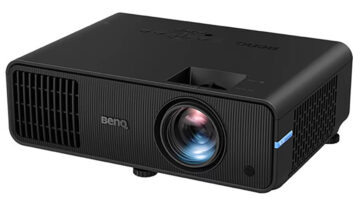In a way, 3D is kind of like a technological cockroach; no one really wants it, but it also just won’t seem to die. The TV manufacturers are making another attempt to bring 3D back to the market, but this time in a glasses-free version.
Technically known as auto-stereoscopic 3D, glasses-free 3D was being implemented in a variety of ways by multiple manufacturers at International CES 2014 last week, and I did my best to visit all of the booths and see the tech in action with my own eyes.
Here’s a rundown of all the latest offerings that I encountered…
IZON

IZON held a press conference last Monday, which was really more of a technical preview of their technology than an actual press event. The demo included a 20-inch TV with IZON tech on board and a Blu-ray player displaying a 3D copy of “Man of Steel,” the latest Superman movie. IZON claimed that it is able to use its tech for real-time 3D gaming, but an issue with the PlayStation on hand prevented them from demonstrating it. Ideal viewing range to experience the 3D effect on the 20-inch panel is three to four feet, and really requires the viewer to be at level with the screen for best results. While there was definitely enhanced depth to the image, it also had a very grainy, lenticular quality to me, reminding me of those old 3D postcards. There was a lot of distortion in the image and both the image and 3D quality were definitely affected by moving my head in any direction. Upon closer examination of the screen, it had a texture to it. Apparently IZON had a 64-inch TV on display in its booth but I was unable to make it over for a viewing.
Sharp

Sharp took glasses-free 3D to the ultimate technical max by displaying it on an 85-inch 8K panel. This is a ton of pixels to use for right and left eye images, and Sharp incorporates Dolby’s glasses-free 3D technology. With such a huge screen and high resolution, there were more spots to stand where the image seemed to work and deliver the 3D effect. However, I constantly felt like the image was rippling and rolling in waves, especially if you moved your head or shifted from side to side. A Gizmodo reviewer wrote, “As you go from a dead center viewing perspective to a wider and wider angle it looks worse and worse. I would argue that Sharp’s prototype barely has a viewing angle. The 3D effect barely works. It just kind of looks like the TV is broken.” The benefit of 8K was totally lost as the image didn’t seem to have even the sharpness and detail of 1080p. Sharp ran a loop of clips from “Frozen” and “Life of Pi.”
Samsung

Samsung’s glasses-free demo was tucked into a back corner of the booth next to an 8K TV. In fact, it was so “out of the way” that I actually missed it on my first booth walk-through, and there was literally no buzz being made about either device on display. This was actually not surprising after looking at the TV. The Samsung set was smaller—around 55 inched—than the sharp and “only” used 4K technology. However, you’d have had no idea that it was 4K as the images lacked any real sharpness and detail and certainly paled next to every other 4K set at CES. The set definitely has a 3D effect, adding depth and dimension and being able to break the screen plane with objects that extended out into the room. However the set exhibited the same rippling and waviness to the image that I noticed from the Sharp TV, and it also had a shimmering-grain to it as well. In fact, it was actually hard on the eyes to watch for very long. Also, the rep said I was a little tall for the display and had me duck down to be at eye level with the display. Apparently even though it was a 4K set, it was actually showing 720p footage. Also, all of the demo material that I saw—some clips of whitewater rafting and people having a food fight—was presented in slow-mo which makes me think that the set might have difficulty with motion.
Sony
One of the very first glasses-free demonstrations that I saw was from Sony, so I made it a point to go to and inquire about the latest gen offerings. Turns out Sony decided to sit out the glasses-free game this CES…
Toshiba
Toshiba didn’t have any 3D—glasses or otherwise—going on in its booth, but apparently the company was displaying its implementation of Stream TV’s Ultra-D glasses-free 3D in its appointment-only suite at the LVH. Unfortunately, I was unable to make an appointment to take a look.
HiSense

This Chinese company has been making a real splash in the TV world recently, and its booth was certainly jam-packed with all the latest buzzword technologies including OLED, curved OLED, and plenty of 4K. Like the other sets, the 55-inch device on which HiSense demonstrated glasses-free 3D definitely had added depth and dimension, but it still suffered from the rippling, warping of images across the screen and that textural quality. It also seemed really prone to needed to be located in a narrow sweet spot as I heard various people proclaiming, “I can’t see it. Oh. Wait. There it is.” The demo material was an Asian film that I wasn’t familiar with.
Stream TV Networks

This is the company behind Ultra-D tech, which is a proprietary technology designed to deliver both display and content conversion and “doesn’t require the human eye to do all the work.” This can also convert all content—even regular 2D programming—into 3D on-the-fly, and is said to alleviate “complaints of motion sickness, limited viewing angles and the need to be in a ‘sweet spot’ to see images in 3D. Ultra-D allows for limitless views so a room full of people can simultaneously share unrivaled 3D experience—no glasses required.”
I’ll be honest, up until visiting this booth, I was ready to completely write off glasses-less 3D as just another gimmick. Every demo that I’d seen up until this point was just that: a gimmick. The images were all but unwatchable for more than 5-10 minutes and would never be something anyone would consider acceptable for daily viewing. But that all changed with the Stream TV demo. The images definitely had depth and pop, but more importantly, weren’t riddled with the other artifacts and rippling and texture that plagued the other displays. I watched several demos on the display, including the trailer for the newly-released film “The Legend of Hercules” and other movie clips, as well as several minutes of someone playing a videogame and then a live TV morning show being converted, and all were very watchable. Moreover, I didn’t feel like I had to lock my head into a fixed position to view, and images didn’t suffer as I got up and moved around. Stream TV’s Ultra-D technology proved to me that glasses-free 3D can actually work!
Haier

As I was leaving the Stream TV booth, they told me that if I wanted to see the tech in action in another booth I could visit the Haier booth. So, that’s where I headed. Not surprisingly, I thought it looked great and it confirmed that Ultra-D is the game-changing technology when it comes to glasses-free 3D.

John Sciacca is principal of Custom Theater and Audio in Myrtle Beach, SC.









